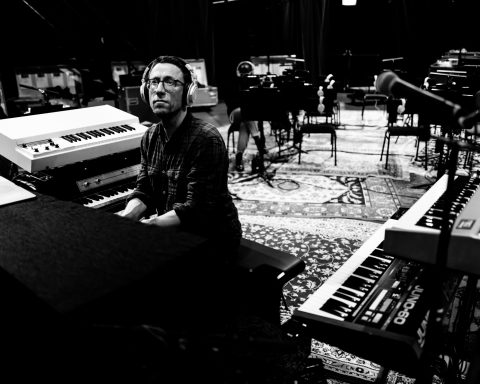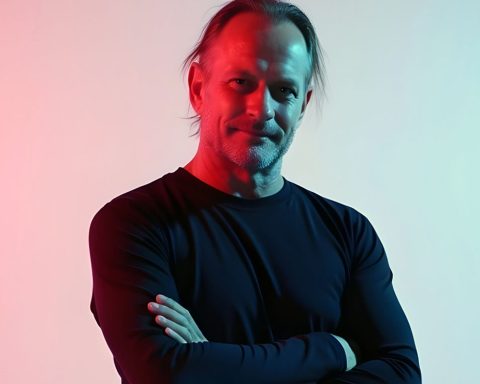Despite arriving in 2009 with the intimate folk LP Leave Ruin, Texas-based Timothy Showalter’s initial attraction to music was sparked by the arpeggiated filter sweeps of the rave scene. The sound of synths first appeared on Strand of Oaks’ sophomore album Pope Killdragon. Since then, Showalter has continued to infuse subtle strains of electronic music into his sound. However, after taking a sabbatical from recording in 2018 to focus on a successful foray into acting, Showalter became exhausted by his public persona. Following a period of deep introspection during which he took up painting and meditation, the songwriter returned to the studio in spring 2023 alongside longstanding collaborator Kevin Ratterman. Letting go of his inhibitions, Strand of Oaks’ eighth LP Miracle Focus sees Showalter fully embrace his formative electronic influences.
BMX for Sale
Is it true that you sold your BMX bike to buy a vintage Roland synth?
I literally grew up in the middle of a cornfield in Indiana where the ’90s rave scene wasn’t really happening. But I fell in love with acid house and got a magazine from a music store that had a Roland MC-303 Groove Box for sale. I was only fourteen, but I cut this page out and hung it on my wall with a mission to work out how I could save for this thing.
I sold my BMX bike and worked at the grocery store, but I couldn’t get the money until one day, I went to the local guitar shop and saw a Roland JX-3P sitting there for $200. Little did I know, but I’d stumbled upon a classic synthesizer. Since then, I think Roland, in particular, created my fascination for electronic music. When I was about 20, I sold the JX for a JUNO-6, and the moment I heard those beautiful rich pads, they wrote the story of Strand of Oaks.
The instrumental track “Walking” from your second LP, Pope Killdragon, is perhaps the clearest evidence of your early fascination with synths.
I can’t remember what I used for that track, but Wendy Carlos helped design a very early digital polyphonic synth with a cartridge system. The person I recorded Pope Killdragon with had these magnificent instruments. Although there’s a beauty to not knowing what you’re doing, I’ve had weird inclinations to go back and re-record Pope Killdragon and wish I could remake “Walking” because I could do so many more things with it.
“I saw a Roland JX-3P just sitting there for $200. Little did I know, but I’d stumbled upon a classic synthesizer.”
Miracle Focus
In what way does your latest LP, Miracle Focus, relate to the twin practice of meditation and painting?
Miracle Focus came from a period where I stopped making music for a while. I was on a TV show for two years and started painting very seriously about three years ago. I didn’t know what I was doing, but I started putting colors together in a very impressionistic way. The idea of Miracle Focus came after I’d looked at this painting for hours and just saw everything. I didn’t realize that I’d begun to empty my mind. I’ve always had a very wild mind, and that constant information, or anxiety, has both served me and hurt me. I didn’t know how to decrease this fear that was crippling my ability to function, but I thought meditation would be a good place to start.
How did that translate to making your eighth album?
I found myself in this place of emptiness—not in a sad way, but in a sense of purification. I had no intention of translating that into music, but when it finally came to do that, it wasn’t through the guitar but the use of synthesizers. I guess Miracle Focus is what my mind associates with the truest form of elevation, but I don’t know if you could call it a dance record. It’s the consuming gorgeousness of electronics married to my approach to songwriting.

A Human-sounding Album
The album has traces of your musical past but is a substantial change in direction. Did it concern you how it might be perceived?
At first, I didn’t know if I wanted to release this. I shut myself off from the music industry because there’s always someone in your ear saying, “Did you get that radio single ready yet?” So I cut off all that noise and spent two years with a MIDI keyboard and some Logic presets, sat down at my keyboard, and channeled it into what I’d call “bliss jams.”
Eventually, I took the files to Kevin Ratterman’s studio in LA, exported my fingers touching the keyboard to his synths, and rebuilt it. It was quite a science experiment, but the feel of the record is very human-performed. When I listen to Kraftwerk or Yellow Magic Orchestra, they’re electronic, but they’re also extremely human. You feel that someone is touching the keys rather than a computer doing all the work.
“I just wanted to make music that feels like a Disney park ride going through all these different locations.”
You seem to be a bit of a magpie, but one that’s happy to disclose your musical influences.
I’m just as influenced by Freddie Mercury as Neil Young, and I think these artists have become saints in the church; they’re always there with me. Alice Coltrane was another life force during Miracle Focus, and Kevin and I loved the Beastie Boys in high school. What I took from them is that they had so much fun in the studio. It felt like they were making music for themselves, and that energy transferred to the listener.
Likewise, Kevin and I created an ecosystem intertwined by our musical DNA. I was such a worrier before, but this time, I just wanted to make music that feels like a Disney park ride while going through all of these different locations.

Relinquishing Control
Working with Kevin, was it difficult to share elements of an activity you’d previously had total control over?
It was difficult. Kevin and I are creatively married, and all marriages have their ups and downs. During the demo process, I got way too deep into the architecture of the record to the point where my wife would walk in, and I’d just be staring at MIDI blocks.
It’s weird to talk about it, but Kevin and I had a pretty bad falling out because I couldn’t relinquish control. In retrospect, that was my fault because I became too protective of demos that had begun to represent something sacred, so when it was time to give them to Kevin, I recoiled from his ideas. I’m embarrassed to say that we didn’t talk for a few months, and yet I don’t think Miracle Focus would exist the way it does without us having had that brutally honest fight.
How did you break out of that and move forward?
Kevin lost his dog, which had been a guardian angel for all of the records we’ve made together. We loved this animal so much, and that’s when I called him and said we need to be friends again and do this thing together. But I have to tell you that once the conflict was resolved, I had the most crystal-clear vision. The physical act of giving him my hard drive was like transferring my soul, but I’d finally got to this place where I could say, “I‘m out of ideas and have nothing left to give, so now it’s your turn.”
“Our secret weapon was the Alpha Juno-1, which is a fantastic tool because it sits somewhere very unique in the mix.”
You mentioned transferring MIDI files to Logic and outputting them through hardware. What hardware specifically?
For Miracle Focus, we wanted to step away from the language of ’80s synthesizers and move towards the big sound effects of the early ’90s FM synthesis world. We call it the Lawnmower Man sound—a moment in time when synth sounds were warm yet icy.
Kevin has a JUNO-106, and I adore that synth and used it on the past three records, but our secret weapon was the Alpha Juno-1, which is a fantastic tool because it sits somewhere very unique in the mix, and you can still pull sounds from it that you don’t hear a lot. It’s also still pretty affordable on eBay compared to how expensive vintage gear is these days.
If only we’d known eBay would exist, we’d have hoarded all our analog gear.
Instead of real estate, people should have bought up all the Roland JP-8s when no one was listening to that kind of music. A friend of mine said that the best day to buy a synthesizer was the day Nirvana’s Nevermind came out, and he ended up selling his keyboards to some pretty heavy hitters who wanted to get back everything they’d sold in the late ’80s.







